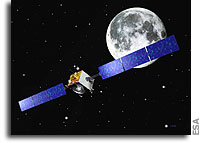SMART-1 Status Report 4 May 2004

ESA’s SMART-1 spacecraft has just made its 278th orbit, in good health and with
all functions performing nominally, but its target is expected to turn blood-red
in the evening of 4 May!
SMART-1’s electric propulsion system (or ‘ion drive’) is being used now to
increase the highest point of SMART-1’s orbit to get closer to the Moon.
The ion engine is still performing very well, and its operation was resumed in
February after it was switched off for a period of three weeks to allow
instrument commissioning activities to take place.
The spacecraft then entered a ‘season’ of long eclipses, due to the alignment of
the Sun and Earth. This was not necessarily a problem except that, when the
spacecraft was in the umbra it could not receive light on its solar panels to
produce power. Although the power system was tested to the limit, the spacecraft
performed excellently.
The eclipse season for SMART-1 is now over but, on Tuesday evening, 4 May 2004,
skywatchers throughout Australia, Asia, Europe, Africa and South America will be
able to see a total lunar eclipse for themselves. The full Moon will pass
through the Earth’s shadow, producing a total lunar eclipse.
A total lunar eclipse occurs when the Sun, Earth and Moon form a near-straight
line in space, so that the full Moon passes through Earth’s shadow. Unlike a
solar eclipse, which requires special equipment to observe safely, you can watch
a lunar eclipse with the naked eye.
The most impressive part starts when the Moon’s leading edge first enters the
main shadow (umbra), and the partial eclipse begins. Over the next hour or so,
the Moon will slip into darkness. The total eclipse begins when the Moon is
fully inside the umbra.
However, the totally eclipsed Moon will not be completely blacked out. It should
still be visible as a dark gray or brown-red disk. This colour is caused by
sunlight scattered in our atmosphere. Its brightness depends on the amount of
dust in Earth’s upper atmosphere at the time, which influences how much sunlight
filters through.
The total phase of this eclipse will last for more than an hour. For observers
in Europe, the Moon will be low in the sky, just above the eastern horizon. The
eclipse starts at 19:51 CEST, and ends at 01:09 CEST on 5 May. The total eclipse
lasts from 21:52 to 23:08 CEST.
More about …
* SMART-1 overview
http://www.esa.int/esaSC/120371_index_0_m.html
Related articles
* Ion drives: Science fiction or science fact?
http://www.esa.int/esaCP/SEM3JQXO4HD_index_0.html
* Gone to the Moon …
http://www.esa.int/esaSC/SEM7AD0P4HD_exploring_0.html
* The science of eclipses
http://www.esa.int/esaSC/SEMYK9R1VED_index_0.html
* What is an eclipse?
http://www.esa.int/esaSC/SEM5N9R1VED_index_0.html
* The eclipse in history
http://www.esa.int/esaSC/SEMQM9R1VED_index_0.html
Related links
* SMART-1 Sci Tech Status Reports
http://sci.esa.int/science-e/www/object/index.cfm?fobjectid=31517
&farchive_objecttypeid=30 &farchive_objectid=30930
IMAGE CAPTIONS:
[http://www.esa.int/export/esaCP/SEMWGG77ESD_index_1.html]








